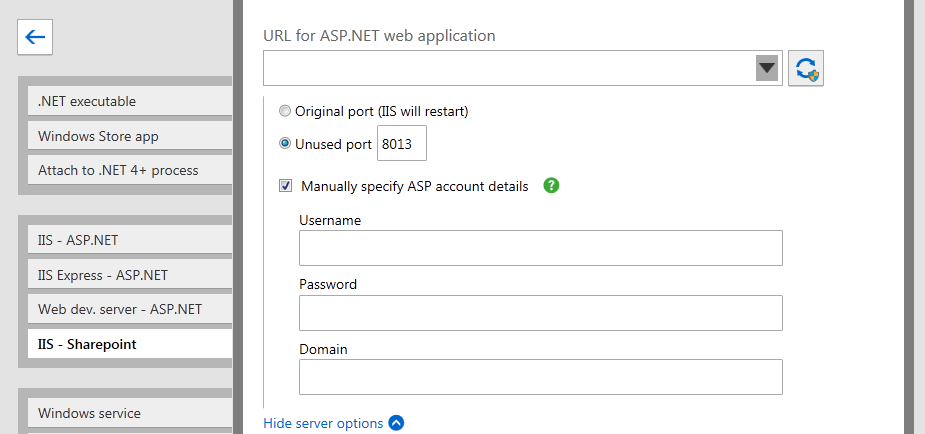Profiling SharePoint
Published 28 August 2014
Setting up a profiling session for SharePoint is similar to Profiling ASP.NET applications running on IIS
You specify a URL for your SharePoint site, optionally choose ports and authentication settings, and specify the performance counters and profiling mode you're interested in.
ANTS Performance Profiler cannot profile SharePoint 2010 or 2013 sites using Claims-based authentication.
You can only profile SharePoint site collections running on the computer where the profiler is installed.
ANTS Performance Profiler can profile managed code that runs on a Microsoft SharePoint 2007, 2010 or 2013 server.
Setting up the Performance Profiler
To profile ASP.NET applications running on IIS:
- From the list of application types, click SharePoint web application (IIS).
- Select the ASP.NET web application (URL) for the SharePoint site that you want to profile.
To load a list of currently-running SharePoint sites into the dropdown list, click
Note that the port specified in this URL is the port where the application usually runs, which is not necessarily the same as the port where the application is to be profiled (see step 4). - Click Show server options and select the port on which to profile your application:
- If your application does not bind to a specific port, select Unused port and choose a port that is not used by IIS.
- If your application must use the port on which it currently runs, select Original port (IIS will restart).
If IIS does not restart correctly, use IIS Manager to stop the website until you have finished profiling.
- If required, in server options, select Manually specify ASP.NET account details and enter the User name, Password and Domain.
ANTS Performance Profiler profiles your web application as the Windows Local System user. If the Windows Local System user might not have appropriate permissions to use your SharePoint site collection, enter the credentials of a user who does have the required permissions. Note that the user you specify must also be an administrator on the computer on which ANTS Performance Profiler runs. - Select the required Profiling mode, Chart performance counters, Additional profiler options, and the browser to launch the application.
For more information, see Working with application settings and Setting up chart performance counters.
Note that SQL queries and incoming HTTP calls will be profiled automatically. - Click
Your SharePoint site launches in the browser you selected.
During the profiling session, use your SharePoint site collection as normal. Any additions that you have coded, such as web parts and lists, will be reflected in the ANTS Performance Profiler results if these objects have been accessed. You can interact with the profiler while your site is still running, selecting regions of the timeline to view results; see The timeline.
Calls to sandboxed web parts run in a separate process under partial trust, and cannot be profiled along with the rest of a SharePoint collection. To profile sandboxed web parts, instead profile SPUserCodeV4 and its child processes as a Windows service: for instructions, see Profiling Windows services.
When you have finished interacting with your web application, click the button in ANTS Performance Profiler to stop profiling.
Closing your browser window will not cause profiling to stop.
Troubleshooting
If you encounter problems while trying to profile a SharePoint application, see Troubleshooting SharePoint profiling.








